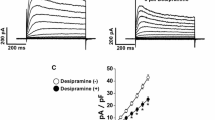Summary
We studied the membrane effects of (1S,2S)-2-(2-[[3-2(benzimidazolyl) propyllmethylamino]ethyl)-6-fluoro-1,2,3,4-tetrahydro-l-isopropyl-2-naphthyl-methoxy-acetate dihydrochloride, Ro 40-5967, a new non-dihydropyridine (DHP) Ca2+ channel antagonist, on dog coronary and saphenous arterial vascular muscle cells using the whole-cell patch-clamp method. Long-lasting (L-type) inward currents in 20 mM Ba2+ were measured over a range of test potentials (300 ms) from −50 mV to + 90 mV from a holding potential of −80 mV in the presence of 1 μM Bay k8644 (a DHP Ca2+ agonist). Ro 40-5967 caused a concentration-dependent suppression of Ca2+ channel currents in muscle cells from both arteries, with greater potency on coronary than saphenous arterial cells. The concentration of Ro 40-5967 which inhibited the magnitude of peak inward currents by 50% (IC50) was estimated to be 1 μM (n = 5) in muscle cells from coronary artery and 10 μM (n = 4) in saphenous artery. Ro 40-5967 (1 μM) decreased the amplitude of the activation current-voltage relationship for coronary L-type Ca2+ channel currents over a wider range of membrane potentials than verapamil, diltiazem, or nifedipine. In contrast, block of Ca2+ channel currents in saphenous artery cells by 1 μM Ro 40-5967 was only observed at command potentials positive to 0 mV. Ro 40-5967 (1 μM) significantly shifted the voltage-inactivation curve downward by 40% in coronary (n = 4), but only by 18% in saphenous arterial muscle cells (n = 3). The non-parallel shift of the coronary artery inactivation curve suggests that pronounced resting channel block is a notable feature of Ro 40-5967. The marked inhibition of Ba2+ current by 1 μM Ro 40-5967 in the inactivation protocol in coronary arterial muscle cells was found over the entire range of membrane holding potentials tested, while inhibition in the saphenous artery inactivation curve occurred only from holding potentials more positive than −40 mV. Therefore, Ro 40-5967 is unique: 1) in acting over a wider range of voltages, on both instantaneous and resting Ca2+ currents, than other Ca2+ antagonists; 2) in producing more significant resting state block; and 3) in acting with selectivity for coronary over saphenous arteries.
Similar content being viewed by others
References
Bühler FR (1990) Calcium antagonists. In: Hypertension: In: Laragh JH, Brenner BM (eds) pathophysiology, diagnosis, and management. Raven Press, New York, pp 2169–2179
Clozel J-P, Osterrieder W, Kleinbloesem CH, Welker HA, Schlappi B, Tudor R, Hefti F, Schmitt R, Eggers H (1991) Ro 40–5967: A new nondihydropyridine calcium antagonist. Cardiovasc Drug Rev 9:4–17
Godfraind T, Miller R, Wibo M (1986) Calcium antagonism and calcium entry blockade. Pharmacol Rev 38:321–416
Hamill OP, Marty A, Neher S, Sakmann B, Sigworth FJ (1981) Improved patch-clamp techniques for high-resolution current recording from cells and cell-free membrane patches. PfIügers Arch 39:85–100
Hermsmeyer K, Robinson RB (1977) High sensitivity of cultured cardiac muscle cells to autonomic agents. Am J Physiol 233:C172-C179
Hess P, Lansman JB, Tsien RW (1984) Different modes of Ca channel gating behaviour favored by dihydropyridine Ca agonists and antagonists. Nature (Lond) 311:538–544
Hosey MM, Lazdunski M (1988) Calcium channels: Molecular pharmacology, structure and regulation. J Membr Biol 104:81–105
Janis RA, Silver P, Triggle DJ (1987) Drugs affecting cellular calcium regulation. Adv Drug Res 16:309–591
Kokubun S, Reuter H (1984) Dihydropyridine derivatives prolong the open state of Ca channels in cultured cardiac cells. Proc Natl Acad Sci USA 81:4824–4827
Marvin W, Robinson R, Hermsmeyer K (1979) Correlation of function and morphology of neonatal rat and embryonic chick cultured cardiac and vascular muscle cells. Circ Res 45:528–540
The Multicenter Diltiazem Postinfarction Trial Research Group (1988) The effect of diltiazem on mortality and reinfarction after myocardial infarction. N Engl J Med 319:385–392
Nowycky MC, Fox AP, Tsien RW (1985) Three types of neuronal calcium channel with different calcium agonist sensitivity nature. Proc Natl Aca Sci USA 82:2178–2182
Packer M, Kessler PD, Lee WH (1987) Calcium channel blockade in the management of severe chronic congestive heart failure: A bridge too far. Circulation 75 [Suppl V]:V-56–64
Sanguinetti MC, Kass RS (1984) Voltage-dependent block of calcium channel current in calf cardiac Purkinje fibers by dihydropyridine calcium channel antagonists. Circ Res 55:336–348
Smith HJ, Goldstein RA, Griffith JM, Kent KM, Epstein SE (1976) Regional contractility: Selective depression of ischemic myocardium by verapamil. Circulation 54:629–635
Triggle DJ (1991) Calcium-channel drugs: Structure-function relationships and selectivity of action. J Cardiovasc Pharmacol 18:51–56
Triggle DJ, Janis RA (1984) The 1,4-dihydropyridine receptor: a regulatory component of the Ca2+ channel. J Cardiovasc Pharmacol 6:S949–955
Triggle DJ, Janis RA (1987) Calcium channel ligands. Ann Rev Pharmacol Toxicol 27:347–369
Tsien RW (1987) Calcium channels: Mechanisms of selectivity, permeation and block. Ann Rev Biophys Biophys Chem 16:265–290
Wagner JA, Guggino SE, Reynolds IJ, Snowman AM, Biswas A, Olivera BM, Snyder SH (1988) Calcium antagonist receptors. Clinical and physiological relevance. In: Vanhoutte PM, Paoletti R, Govoni S (eds) Calcium antagonists. Pharmacology and clinical research, vol 522. The New York Academy of Sciences, New York, pp 116–133
Author information
Authors and Affiliations
Additional information
This research was supported by National Institutes of Health grants HL38537, HL38645, and by F. Hoffmann-La Roche, Basel, Switzerland
Rights and permissions
About this article
Cite this article
Bian, K., Hermsmeyer, K. Ca2+ channel actions of the non-dihydropyridine Ca2+ channel antagonist Ro 40-5967 in vascular muscle cells cultured from dog coronary and saphenous arteries. Naunyn-Schmiedeberg's Arch Pharmacol 348, 191–196 (1993). https://doi.org/10.1007/BF00164798
Received:
Accepted:
Issue Date:
DOI: https://doi.org/10.1007/BF00164798




